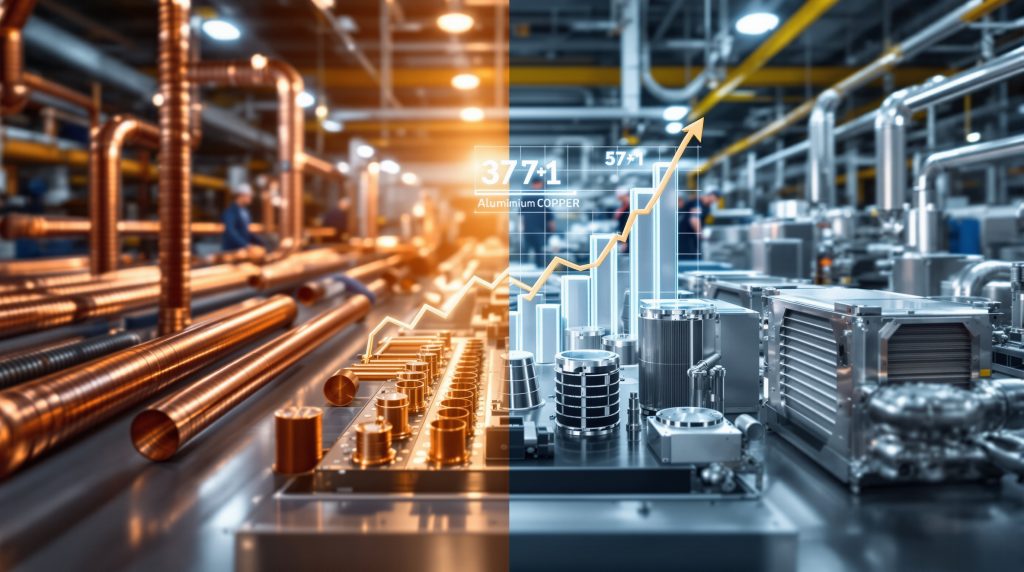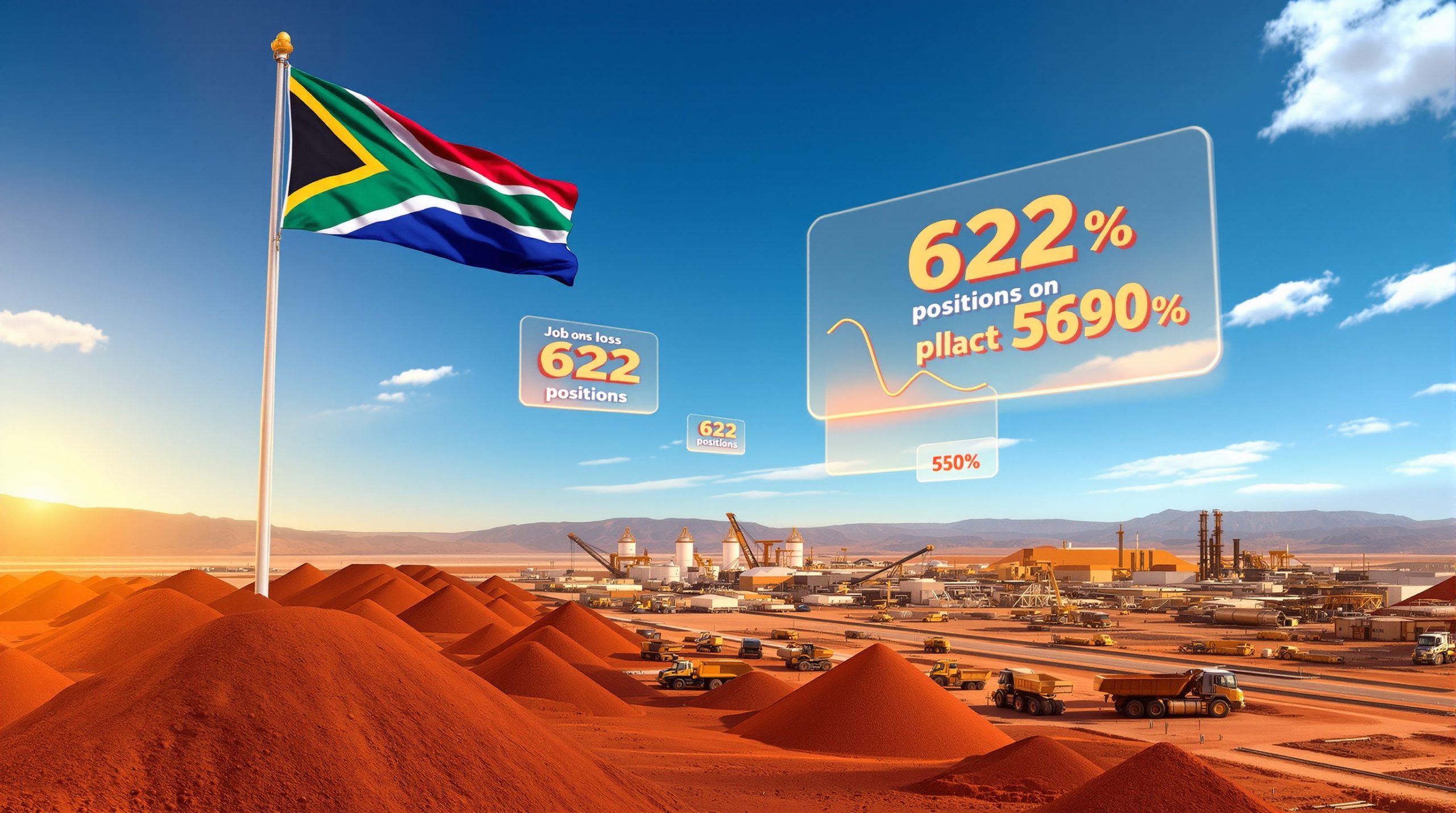The Evolution of HVAC Systems: Copper to Aluminium Substitution
The heating, ventilation, and air conditioning (HVAC) industry is experiencing a significant material transformation, with aluminium increasingly replacing copper in critical components. This substitution trend is reshaping manufacturing practices, cost structures, and performance considerations across the global HVAC sector. Recent copper price insights have further accelerated this transition as manufacturers seek cost-effective alternatives.
Economic Factors Fueling the Transition
The primary driver behind this material shift is the substantial cost differential between copper and aluminium. With copper trading at nearly four times the price of aluminium, manufacturers face compelling economic incentives to adopt alternative materials. This price gap has remained consistently above the critical 3.5x threshold that typically triggers substitution behaviors across industries.
According to Lionel Chapis, Senior VP at Norsk Hydro's Precision Tubing division, "When copper is three times more expensive than aluminium, the aluminium solution will be approximately two times cheaper at similar performance." This economic reality has driven rapid adoption across the industry.
Current Market Penetration Statistics
Recent industry data indicates aluminium has captured approximately 40% of the global HVAC component market—doubling its presence over just five years. This rapid adoption rate signals a fundamental shift in manufacturing priorities and material selection criteria.
Major manufacturers are leading this transition, with companies like Daikin Industries (the world's largest manufacturer of air conditioning systems) announcing plans in 2021 to halve copper use in their air-conditioning units by 2025 through aluminium substitution. The ongoing mining industry evolution has also influenced how these materials are sourced and processed.
How Does the Price Relationship Between Copper and Aluminium Impact Substitution?
The Critical Price Ratio Analysis
The copper-to-aluminium price ratio serves as a key indicator for predicting substitution behaviors. As of August 2025, this ratio stands at approximately 3.7:1, well above the traditional 3.5:1 threshold that industry analysts identify as the tipping point for accelerated substitution.
| Metal | Current Price (Aug 2025) | Price Ratio |
|---|---|---|
| Copper | ~$9,820 per tonne | 3.7:1 |
| Aluminium | ~$2,620 per tonne |
According to a September 2024 report by mining giant BHP, "the copper-to-aluminium ratio has been in excess of 3.5 for much of the past five years, supporting our belief that the price ratio needs to be around 3.5 to 4 times before greater levels of substitution occur."
Cost Savings Quantification
When factoring in total system costs, HVAC manufacturers report that aluminium solutions typically deliver approximately 50% cost savings compared to copper equivalents. These economics remain compelling even in markets facing aluminium import tariffs, such as the United States, where manufacturers continue to prioritize aluminium despite the additional costs. Furthermore, recent tariff impact analysis suggests that these economic incentives will likely persist despite trade policy fluctuations.
Industry experts note that US HVAC manufacturers demonstrate particularly strong cost management focus, showing willingness to pay additional tariff costs because the total economics still favor aluminium over copper.
What Technical Challenges Exist When Substituting Aluminium for Copper?
Design Modification Requirements
Successful copper to aluminium substitution in HVAC systems requires comprehensive system redesign rather than simple material replacement. Engineers must account for aluminium's different thermal conductivity, corrosion characteristics, and mechanical properties when developing new components.
According to industry specialists, aluminum adoption cannot be as simple as switching materials while maintaining the same design or system. Lionel Chapis explains, "In order to successfully adopt aluminium, you need to redesign the shape—for example, replacing copper tubes with micro channel extrusions—and re-engineer the system."
Microchannel Technology Advancement
The development of microchannel extrusion technology has been crucial in overcoming aluminium's inherent thermal conductivity limitations. This innovation allows manufacturers to create heat exchanger designs that maximize aluminium's performance while minimizing material usage.
Microchannel technology involves creating complex internal geometries that compensate for aluminium's lower thermal conductivity (235 W/m·K compared to copper's 400 W/m·K) by increasing surface area and optimizing fluid dynamics. As highlighted in a recent study by Fastmarkets, these technological adaptations have been critical to maintaining performance while reducing costs.
Corrosion Resistance Considerations
Unlike copper, which offers superior natural corrosion resistance, aluminium components typically require protective coatings or treatments to ensure longevity, particularly in coastal or high-humidity environments. These additional processing requirements partially offset the raw material cost advantages.
Leonardo Energy, a knowledge platform supported by the European Copper Institute, notes that copper demonstrates superior corrosion resistance in extreme or saline environments, while aluminium often requires additional treatment or protection. These factors can increase maintenance requirements in certain applications.
Which HVAC Components Are Most Affected by Aluminium Substitution?
Heat Exchangers and Coils
Condenser and evaporator coils represent the primary battleground for material substitution, with aluminium making its most significant inroads in these components. The transition began with condenser coils and has progressively expanded to evaporator applications.
According to industry experts, heat exchanger and air conditioning applications are showing particularly strong aluminum adoption trends. This follows a pattern similar to the automotive industry's transition—in the early 1990s, Volkswagen made the first decision to replace copper with aluminium tubes in car radiators, and today most automotive radiators are aluminium-based.
Refrigerant Tubing Systems
Aluminium has demonstrated particular success in replacing copper in refrigerant distribution systems, where its lighter weight and lower cost provide immediate benefits without significant performance compromises.
Manufacturers have developed specialized joining techniques and connection systems to address the challenges of creating reliable, leak-free aluminium refrigerant circuits that can withstand system pressures and temperature cycles.
Structural Components
Beyond heat transfer applications, aluminium's natural weight advantages have made it the preferred material for HVAC system frames, housings, and structural supports, further reducing copper dependency across the industry.
These non-thermal components represent an "easy win" for aluminium adoption, as they don't face the same thermal conductivity challenges as heat transfer surfaces while still benefiting from aluminum's lower cost and weight.
How Does Regional Adoption of Aluminium in HVAC Systems Vary?
North American Market Leadership
The United States has emerged as the global leader in aluminium adoption for HVAC applications, with manufacturers embracing the material despite tariff considerations. This accelerated transition reflects the market's strong emphasis on cost optimization and pragmatic performance standards.
According to Norsk Hydro, "The region that is moving the fastest is the US, even after the US tariff. The heating, ventilation and air conditioning OEMs [original equipment manufacturers] in the US have a strong 'fit for purpose' orientation and are experts at cost management."
US customers remain willing to pay the additional cost from the 50% tariff on aluminium because the overall economics still favor aluminium over copper in most applications.
European Transition Patterns
European manufacturers have demonstrated a more measured approach to aluminium substitution, balancing cost considerations against the continent's traditionally higher energy efficiency standards and longer expected equipment lifespans.
European regulations often place greater emphasis on lifetime performance and energy efficiency, sometimes slowing the transition to aluminium in applications where even small differences in thermal performance might impact system efficiency ratings.
Asian Market Dynamics
Asian markets show the most varied adoption patterns, with some regions maintaining strong preferences for copper-based systems due to consumer perceptions of quality and durability, while others rapidly transition to aluminium to maintain competitive pricing.
In Japan, major manufacturers like Daikin are actively leading the transition, while other Asian markets show more variation based on local production capabilities, cost sensitivities, and market expectations.
What Performance Differences Exist Between Copper and Aluminium HVAC Systems?
Thermal Conductivity Comparison
Copper's thermal conductivity (approximately 400 W/m·K) significantly exceeds aluminium's (approximately 235 W/m·K), requiring aluminium systems to incorporate larger heat exchange surfaces or enhanced designs to achieve comparable performance.
According to cable manufacturer Nexans, aluminium conductors must be around 1.6 times thicker than copper to achieve the same conductivity. This dimensional difference requires careful system redesign to maintain performance while minimizing material usage.
Weight and Installation Advantages
Aluminium components weigh approximately 30% less than copper equivalents, offering significant advantages in transportation, handling, and installation—particularly for larger commercial systems where weight considerations impact structural requirements.
This weight reduction can lead to lower shipping costs, easier handling during installation, and reduced structural support requirements for roof-mounted systems—all factors that contribute to aluminum's total value proposition beyond simple material cost savings.
Durability and Service Life Expectations
Industry testing indicates copper-based systems typically offer 5-10% longer operational lifespans than aluminium equivalents, particularly in challenging environments. However, this performance gap continues to narrow as aluminium alloy technology and protective treatments improve.
The durability differential is most pronounced in coastal areas, industrial settings with corrosive atmospheres, and applications with frequent thermal cycling or condensation exposure, where copper's inherent corrosion resistance provides an advantage.
How Are Major HVAC Manufacturers Responding to the Substitution Trend?
Strategic Material Diversification
Leading global manufacturers are increasingly adopting dual-material strategies, offering both copper and aluminium options across their product lines to address different market segments and price points.
This approach allows manufacturers to provide premium copper-based options for applications where maximum performance and longevity are prioritized, while offering more economical aluminium alternatives for price-sensitive market segments.
Research and Development Focus
Significant R&D resources are being directed toward improving aluminium system performance, with particular emphasis on enhancing corrosion resistance, optimizing thermal transfer efficiency, and developing more effective joining techniques.
These efforts include developing specialized aluminum alloys with improved thermal conductivity, advanced surface treatments to enhance corrosion resistance, and innovative heat exchanger geometries that maximize performance while minimizing material usage.
Supply Chain Restructuring
The shift toward aluminium is triggering substantial changes in HVAC manufacturing supply chains, with companies developing new supplier relationships, investing in specialized aluminium processing equipment, and relocating production facilities to optimize material sourcing. Recent global copper supply forecast data has reinforced the necessity of this transition for many manufacturers.
Manufacturers are increasingly integrating vertically to control aluminium processing capabilities or forming strategic partnerships with aluminium suppliers to ensure consistent quality and supply security as demand continues to grow.
What Impact Does Material Substitution Have on HVAC Energy Efficiency?
System Efficiency Considerations
When properly designed, aluminium-based HVAC systems can achieve energy efficiency ratings within 3-5% of comparable copper systems, though this performance gap widens under extreme operating conditions or after extended service periods.
The efficiency difference stems primarily from aluminum's lower thermal conductivity, which can reduce heat transfer effectiveness in certain conditions. However, advanced design techniques like increased surface area, enhanced fin designs, and optimized refrigerant flow patterns help minimize this difference.
Environmental Impact Analysis
The environmental equation extends beyond operational efficiency to include manufacturing energy requirements, where aluminium's lower melting point offers processing advantages that partially offset its slightly lower operational efficiency.
Primary aluminum production is energy-intensive, but the metal's recycling efficiency (requiring only 5% of the energy needed for primary production) and the smaller quantity required per component (due to lower density) factor into its overall environmental profile. Many manufacturers are now incorporating sustainable mining transformation practices in their material sourcing decisions.
Lifecycle Assessment Perspectives
Complete lifecycle analyses indicate that aluminium systems typically demonstrate lower overall environmental impacts when accounting for raw material extraction, manufacturing energy, transportation, operational efficiency, and end-of-life recyclability.
The recyclability of aluminum (nearly 100% recyclable with minimal quality loss) provides additional environmental benefits at end-of-life compared to copper, though both metals feature high recycling rates compared to many other materials.
How Does Copper Supply Influence the Substitution Trend?
Global Copper Production Challenges
The copper mining sector faces significant challenges in expanding production to meet growing demand, with declining ore grades, permitting difficulties, and substantial capital requirements constraining new project development.
According to Fastmarkets research, copper will require $350 billion in investment by 2040 to meet projected demand—yet even this would result in a 30% supply shortfall by 2035, according to the International Energy Agency's Global Critical Minerals Outlook 2025.
Copper Concentrate Market Dynamics
The market for copper concentrate has tightened considerably, with treatment charges turning negative in 2025 as smelters compete for limited supplies—a situation that further supports the economic case for aluminium substitution.
Fastmarkets calculated the weekly copper concentrates treatment charge (TC) index at $(62.10) per tonne in late August 2025, representing the fees miners receive from smelters to process raw material into refined copper. Negative treatment charges indicate extreme scarcity of raw materials.
Long-Term Supply Outlook
Industry forecasts project a potential copper supply deficit exceeding 900,000 tonnes by 2035, suggesting that material substitution pressures are likely to intensify rather than abate over the coming decade.
As one industry expert notes, "Over the next five years, we forecast global primary aluminium supply to potentially reach the 100-million-tonne mark, with rapid growth coming out of Indonesia. Meanwhile, a copper mine shortage and lack of meaningful investment in brownfield projects has increased the risk of a deeper copper shortage."
What Future Developments Are Expected in HVAC Material Technology?
Advanced Aluminium Alloy Development
Metallurgical research continues to yield aluminium alloys with improved thermal conductivity, corrosion resistance, and mechanical properties specifically optimized for HVAC applications.
These specialized alloys often incorporate small amounts of copper, zinc, manganese, or other elements to enhance specific properties while maintaining aluminum's core advantages of light weight and lower cost.
Hybrid Material Systems
Emerging technologies combine copper and aluminium in strategic configurations that maximize the performance advantages of each material while minimizing total system costs.
These hybrid approaches might use copper in the highest-performance sections of a heat exchanger while employing aluminum for the remainder, or create bimetallic components that bond the metals together to leverage their complementary properties.
Alternative Material Exploration
Beyond the copper-aluminium dichotomy, manufacturers are investigating other materials including polymer composites, carbon-based materials, and specialized steel alloys for specific HVAC applications.
Advanced polymers with enhanced thermal conductivity show promise for certain low-pressure components, while carbon-based materials like graphene-enhanced composites represent a longer-term research direction that could eventually supplement or replace traditional metals in some applications.
FAQs About Copper to Aluminium Substitution in HVAC Systems
Does switching to aluminium affect HVAC system performance?
When properly engineered, aluminium-based systems can deliver comparable performance to copper systems, though they typically require larger heat exchange surfaces or enhanced designs to compensate for aluminium's lower thermal conductivity. Modern system designs have largely overcome these challenges through advanced engineering approaches.
Are aluminium HVAC components less durable than copper?
Aluminium components generally have slightly shorter expected lifespans than copper equivalents, particularly in corrosive environments. However, modern protective treatments and alloy improvements have significantly narrowed this durability gap. In standard residential applications, the difference may be negligible with proper maintenance.
How much cost savings does aluminium substitution provide?
Manufacturers typically report 40-50% cost savings when switching from copper to aluminium components, even after accounting for necessary design modifications and protective treatments. These savings stem from both the raw material price differential and aluminum's lighter weight, which reduces shipping and handling costs.
Will copper ever regain market share in HVAC applications?
Industry experts consider the shift to aluminium largely irreversible in most applications, as manufacturers have invested heavily in aluminium-specific production technologies and design approaches that would be costly to abandon. As one industry expert notes, "Once you get through all that, customers don't go back to using copper and stick with aluminium."
How does aluminium substitution affect HVAC system weight?
Aluminium-based systems typically weigh 30-40% less than copper equivalents, offering advantages in transportation, installation, and structural loading requirements, particularly for larger commercial applications. This weight reduction can be especially significant for roof-mounted systems where structural support limitations may be a factor.
Does aluminium substitution impact refrigerant compatibility?
Most modern refrigerants are compatible with both copper and aluminium systems, though some older refrigerants may require special considerations when used with aluminium components. The transition to newer, more environmentally friendly refrigerants has generally aligned well with the shift toward aluminium components.
Further Exploration
Readers interested in learning more about trends in metal substitution in industrial applications can also explore related educational content from Fastmarkets, which offers market analysis on various metals including copper and aluminium.
Are You Tracking the Next Major Mineral Discovery?
Don't miss the opportunity to gain a market-leading edge with Discovery Alert's real-time notifications on significant ASX mineral discoveries, powered by their proprietary Discovery IQ model. Visit the Discovery Alert discoveries page to understand how major mineral findings can lead to substantial market returns and begin your 30-day free trial today.




